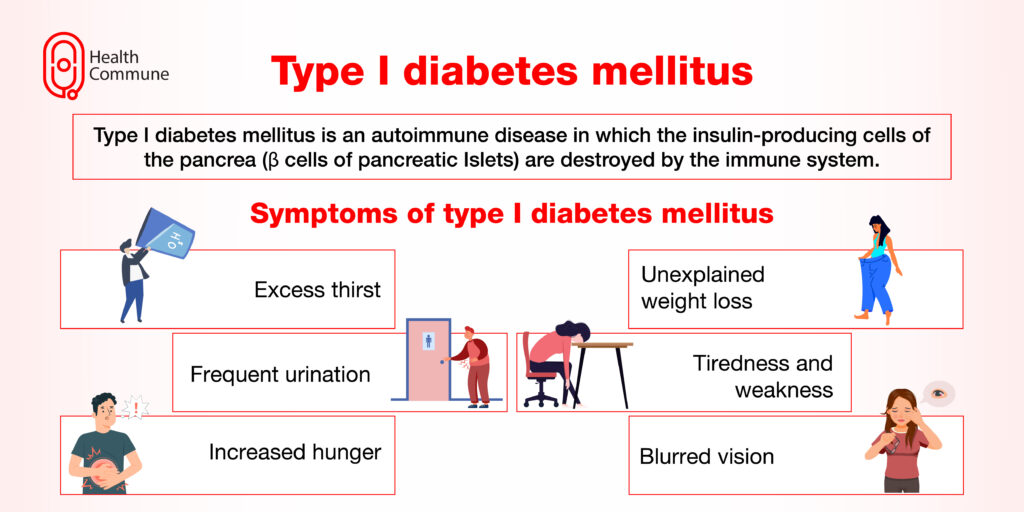What is type I diabetes mellitus?
Type I diabetes mellitus is an autoimmune disease in which the insulin-producing cells of the pancreas (β cells of pancreatic islets) are destroyed by the immune system.
Insulin is the chief regulator of glucose; it promotes the uptake of glucose by various body cells and its storage in the liver. Without insulin, glucose is unable to enter blood cells, causing blood glucose levels to increase (hyperglycemia).
What causes type I diabetes mellitus?
The exact aetiology that triggers the immune system to destroy the insulin-producing β cells is still unclear, although it is postulated that certain genes are linked to increased susceptibility. The damage goes unnoticed initially for months or years as insulitis (inflammation of the beta cells). Eventually, the patient develops an absolute lack of insulin in the body, resulting in hyperglycemia and increased acidity of the blood.
Previously called juvenile-onset diabetes or insulin-dependent diabetes mellitus, type I diabetes is usually identified during childhood itself.
What factors determine the risk of developing type I diabetes mellitus?
- Family history: Anyone who has a parent or sibling who has type 1 diabetes is at a slightly higher risk of getting the disease
- Genetics: Certain genes that are associated with an increased risk include HLA-DQA1, HLA-DQB1, and HLA-DRB1
- Age: Type 1 diabetes can develop at any age; however, there are two distinct peaks in its occurrence. Children between the ages of 4 and 7 experience the first peak, and children between the ages of 10 and 14 experience the second
- Viruses: This condition may also be associated with exposure to certain viruses such as enterovirus. Children born to mothers with coxsackievirus or another enterovirus during pregnancy have the risk of developing type I diabetes
- Dietary factors: This disease is linked with increased consumption of cows’ milk, early introduction of cereals and is also higher among those suffering from coeliac disease

How does type I diabetes mellitus typically present?
Symptoms of type I diabetes mellitus most commonly include:
- Excess thirst
- Frequent urination
- Increased hunger
- Unexplained weight loss
- Tiredness and weakness
- Bedwetting in children who did not previously wet the bed during the night
- Blurred vision
What are the tests for type I diabetes mellitus?
- Blood tests
- Fasting blood glucose levels (after 10-12 hours of overnight fasting)
- Postprandial glucose levels (2 hours after the meal)
- Glycosylated haemoglobin level (HbA1C)
- Glucose tolerance test
- Lipid profile
- Liver function tests
- Serum creatinine level
- Tests for pancreatic autoantibodies
- Urine test: For detecting glucose, proteins, albumin to creatinine ratio and GFR (glomerular filtration rate)
What is the treatment for type I diabetes mellitus?
All patients with type I diabetes mellitus require insulin to manage their symptoms. The dose of insulin is determined based on various factors such as your diet and physical activity.
Insulin can be administered by:
- Multiple daily injections
- Continuous subcutaneous infusion through insulin pumps
There are different types of insulin (short-acting insulin, intermediate-acting insulin, long-acting insulin and ultra-long-acting insulin) based on how fast they act. Your doctor will prescribe the insulin that is most suited to you.
It is important to monitor glucose levels in order to maintain a steady level of glucose in the body. Some of the systems that make it possible include :
- Continuous glucose monitoring: Sensors inserted into the subcutaneous tissue measure glucose levels at regular intervals and alert you if there are any significant fluctuations
- Closed-loop system: In this, the sensors are connected to the insulin pump. This device measures glucose levels at regular intervals and communicates with your insulin pump which subsequently delivers insulin from time to time based on body requirements. It functions like an artificial pancreas
In addition to insulin, you may be required to take medicines to lower blood pressure and cholesterol levels.
You’ll also be required to make certain lifestyle changes such as eating healthy food that is low in carbohydrates and following a physically active life. It’s imperative to make regular exercise a part of your lifestyle.
How will type I diabetes impact my pregnancy?
If you have type I diabetes, you must plan your pregnancy in advance. Your blood sugar level should be controlled and ideally, the HbA1C should be less than 6.5%. Mothers with type I diabetes have an increased risk of:
- Preeclampsia
- Insulin resistance (cells become more resistant to insulin)
- Miscarriage
- Macrosomia (here, your baby is larger than the average expected weight (greater than 4 kg))
- Birth defects in the baby
If you are pregnant, consult your diabetes specialist and gynaecologist. They will be able to guide you to control your sugar level effectively.
What complications might type I diabetes mellitus cause?
- Damage to the peripheral nerves (neuropathy): This is a complication of diabetes that occurs over a long period , usually 10 to 12 years and commonly affects the feet and legs. It involves a burning, tingling or pins and needles sensation. Eventually, it can lead to a complete loss of sensation
- Damage to the retina (retinopathy): High blood sugar levels can lead to damage to the blood vessels in the eyes, leading to blurring of vision, floaters and eventual blindness
- Damage to the kidneys (nephropathy): Another long-standing complication, in which the kidneys stop functioning properly, leading to eventual kidney failure
- Heart disease: Diabetes can lead to damage to the blood vessels of the heart and increased risk of atherosclerosis, coronary heart disease, and high blood pressure
- Diabetic ketoacidosis: The absence of insulin leads to increased breakdown of proteins and fats making the blood acidic. A person with diabetic ketoacidosis typically has a fruity breath, confusion and sometimes loss of consciousness
- Diabetic foot: Neuropathy can allow injuries to go unnoticed, leading to serious foot infections and possible amputations
Is type I diabetes mellitus curable?
Type I diabetes is a lifelong condition with no known cure to date. Although pancreatic transplants and islet cell transplants are emerging as alternate curative treatment options, there are significant risks associated with them. If you are a type I diabetic, it is indeed challenging to continuously maintain normal blood sugar levels. However, that’s the only way to prevent diabetes-related complications. Hence, follow the treatment strictly and make all the necessary lifestyle changes to ensure good quality of life.





